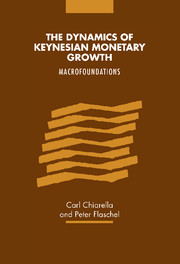Book contents
- Frontmatter
- Contents
- List of figures
- Foreword by Richard H. Day
- Preface
- Acknowledgments
- Notation
- General introduction
- 1 Traditional monetary growth dynamics
- 2 Tobinian monetary growth: the (neo)Classical point of departure
- 3 Keynes–Wicksell models of monetary growth: synthesizing Keynes into the Classics
- 4 Keynesian monetary growth: the missing prototype
- 5 Smooth factor substitution: a secondary and confused issue
- 6 Keynesian monetary growth: the working model
- 7 The road ahead
- References
- Author index
- Subject index
3 - Keynes–Wicksell models of monetary growth: synthesizing Keynes into the Classics
Published online by Cambridge University Press: 22 September 2009
- Frontmatter
- Contents
- List of figures
- Foreword by Richard H. Day
- Preface
- Acknowledgments
- Notation
- General introduction
- 1 Traditional monetary growth dynamics
- 2 Tobinian monetary growth: the (neo)Classical point of departure
- 3 Keynes–Wicksell models of monetary growth: synthesizing Keynes into the Classics
- 4 Keynesian monetary growth: the missing prototype
- 5 Smooth factor substitution: a secondary and confused issue
- 6 Keynesian monetary growth: the working model
- 7 The road ahead
- References
- Author index
- Subject index
Summary
In their book, Ferri and Greenberg (1989, ch. 4) present some nonlinear deterministic labor-market theories of business cycles which are based on three variants of what they call the missing equation, i.e., the Phillips curve mechanism. The three approaches they consider are Rose (1967), Goodwin (1967) and Ito (1980), which make use of a special nonlinear money-wage Phillips curve, a linear real-wage Phillips curve, and a piecewise linear (regime switching) real-wage Phillips curve, respectively. In addition, an equation describing capital accumulation is derived in each of the three cases, and also a price adjustment equation in the case of Rose's model.
In the present chapter, we shall make use of a general model of Keynes–Wicksell type to show that these and other well-known models of cycles and growth can all be considered as special cases of this prototype model, so that they all belong to one particular theory, which despite its “Keynes–Wicksell” origin is fairly (neo)Classical or supply-side oriented in nature. Such a statement does not, in our view, devalue this model type from a Keynesian perspective, but it leads us instead to a general and unifying framework of Keynes–Wicksell models with which models that attempt to be of a (more) Keynesian type can be usefully compared.
Since our general Keynes–Wicksell prototype model synthesizes Goodwin's Classical growth cycle and Rose's “Keynesian employment cycle” (based on sluggish wages and prices and smooth factor substitution), it must inherit the dynamic features of these real models to some extent.
- Type
- Chapter
- Information
- The Dynamics of Keynesian Monetary GrowthMacro Foundations, pp. 127 - 172Publisher: Cambridge University PressPrint publication year: 2000



